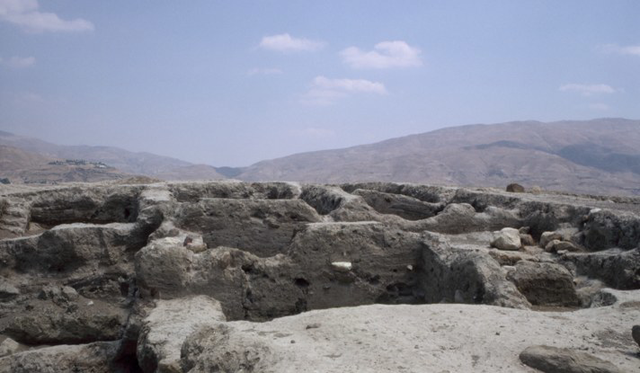AMMAN — Scholars have speculated that in the Late Bronze Age, a trade route existed between Wadi Zarqa, Deir Alla and the Amman plain, extending to the Canaanite territories and Egypt.
This trade route could have been maintained by the local population of the area, mainly Canaanites, even though it was an extension of Egyptian trade routes west and east of the Jordan. The plain of Amman is here considered to have been a city state, possibly with Sahab as its economic hub.
"It was dominated by a Canaanite tribe, or a coalition of tribes, and its economy was largely based on the international trade between the west and the north, and possibly the south," noted Eveline Johanna van der Steen from Leiden University, adding that for contacts with the east, the desert region, there is no evidence so far.
Professor Muawiyah Ibrahim from Yarmouk University proposed that, due to its location on the edge of the desert, Sahab was an important commercial centre.
According to McGovern, a transhumance route may well have existed between the Baqah plain and the Jordan Valley, going through the Zarqa Valley.
“Wandering nomads moved from the plain, where they stayed in summer, to the Jordan Valley in winter. This practice certainly existed in the 19th century AD,” Van der Steen said.
He added that if there was an actual trade route in the Late Bronze Age, it is to be expected that the mobile population of the region was involved in it. Bedouins certainly were involved in trade in the 19th century AD, transferring goods from Salt to Jerusalem and Nablus.
"However, surveys have never produced any pottery from the Late Bronze Age in the Zarqa Valley. Late Bronze Age material was found in the Baqah plain, and at the other end of the route in the Jordan Valley, but nowhere in between," Van der Steen explained.
Moreover, excavations in 1996 and 1997 on Tell Hammeh, north bank of the Wadi Zarqa have demonstrated that this site, right at the entrance of the Zarqa Valley, was used in the Late Bronze Age and the Middle Bronze Age.
"The tell lies on a natural hill, and rises about seven metres above its surroundings, and it was noticed by Glueck, Gordon and Villiers during their Wadi Zarqa survey and also by the East Jordan Valley Survey. Based on the survey results, the site was thought to be settled in the Early Bronze Age, and the Early Iron Age up to the Persian period," Van der Steen highlighted.
He added that the excavations revealed occupation layers from the Chalcolithic and Early Bronze Ages, and, after a gap, from the end of the Middle Bronze Age to the end of Iron Age II.
No sherds from either period were found during the surveys, which opens the possibility that similar material may be found in other parts of the Zarqa Valley, even though the surveys never revealed any Late Bronze Age occupation.
"The very simple and transitory architecture from the Late Bronze Age layers suggests the presence of a mobile group or groups using the site on a temporary basis, a transhumant population perhaps. At the same time, the fine pottery suggests that they were in contact with main cultural centres and that the pottery they carried may have had another significance than simply functional, daily ware," Van der Steen said.
A possible explanation is that they were involved in trade, moving from one market centre to another, and some of the pottery they carried was related to the trade.
"If we accept this hypothesis, the next question is which road the trade route followed. The fact that Tell Hammeh lies at the mouth of the Zarqa Valley suggests that it actually went through this valley," Van der Steen speculated, noting that it has been stated above that the fact that no survey so far has turned up actual Late Bronze Age pottery in the valley does not automatically mean that it did not exist.
A number of sites have shown the presence of Early Iron Age pottery: (from west to east) Tell Hammeh; Sabgha and the Zighan caves; Tell Mghanni; Iraq Tahuna; Tulul Dhahab (east and west, main period of occupation); the gypsum mine on the south side of the Zarqa; Tell Ghreimun.
After the collapse of the Egyptian Empire, some Early Iron Age settlements were created, especially in the highlands east and west of the Jordan and in the East Jordan Valley.
"It is to be expected that these settlements were first and foremost founded on locations that were already known to the new settlers. The newly settled Early Iron Age sites along the Zarqa therefore may be an indication of the road these nomads took in their wanderings between the Amman plain and the Jordan Valley," Van der Steen underscored.
